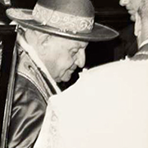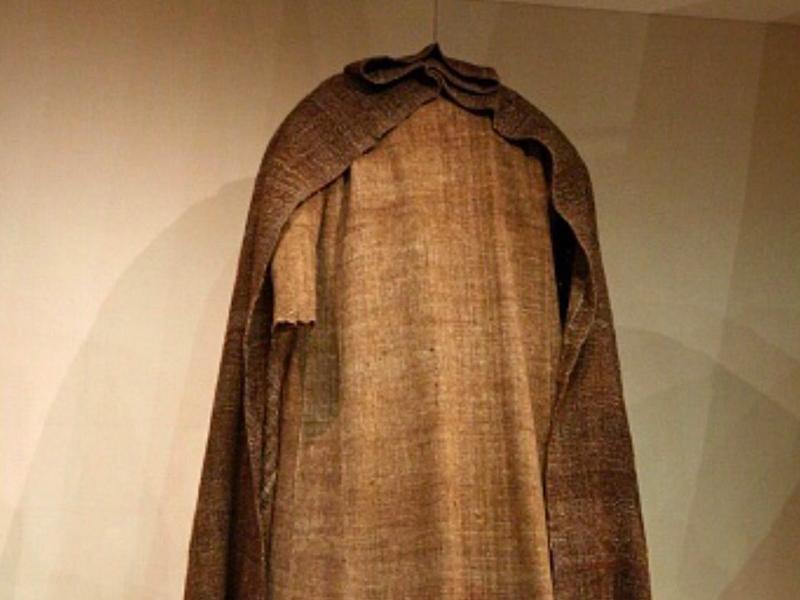Le visite dei pontefici


The biographies offer a vivid image of the intimate relationship that bound these two great Saints of the Christian
By D. Mechthild Flury in St. Francis Patron Saint of Italy n.2 Feb 1989)
As biographers tell us, Saint Francis used to give his clothes to the poor. When this form of his generosity started to damage his health, his Brothers were forced to forbid him from this action, reminding him of obedience. If we believe these stories, it is not surprising that so many of the Saint’s tunics or habits have reached our days. One of these can be found in Cortona, where it appears that it was brought by Brother Elia, a close confidant of the Saint. A second habit, made of white wool, is preserved in the Convent of Saint Clare in Assisi, and a third habit, finally in the Sacred Convent. The oldest piece of information on the latter is found in the Codice 344, fol 73 ss of the Municipal Library of Assisi, in which it was mentioned as early as 1350 as an object of inventory.
The habit is made of rough, crumpled wool. The color is dark grey, as the natural shades of wool allow, because the fabric is not dyed. The grey color is obtained by spinning different types of natural wool. In this way, the processing of brown and beige wool, mixed together according to precise parameters, which allow one to obtain dark grey. However, if the brown wool component is increased, the product will be of a color which is closer to brown than grey. From the original seams which are preserved, it is possible to identify the cut of the original habit easily.
On the front and on the back there is a 60 cm wide ring of fabric that forms the central part to which several segments are connected laterally, so as to create the shape of a habit. In the seams the pieces of cloth overlap each other by half a centimeter, and the edges are sewn on both sides with linen yarn using overlocking stitches. A linen cover covers a large part of the front and back, as well as the right sleeve from the inside. It is connected with visible stitches of linen yarn, in the front and back halves, to the outer fabric and is fixed at the edges with overlocking stitches. On the sides there is no lining.
The right sleeve has a superimposed linen pocket. The pocket for alms under the sleeve is one of the obligatory components of a Franciscan habit. The left sleeve was lost. What is fundamental about the general appearance of this relic are the numerous pieces of wool, large and small, attached to the habit. Under these patches there are, as far as it is possible to ascertain despite the interference of the lining, fringed holes without traces of cuts and in certain points, even several small holes next to one another. These empty spots have been improved with a total of six different pieces of wool, each of which is present with two or three pieces. The exception is a piece of rather rough, brownish wool, which is present on the habit nineteen times. This fabric, often in large pieces, was sewn to the habit all by the same hand. The seams of these pieces are particular. The edges of the cut are followed by a linear linen thread that forms the seam closing it with a stitch. Instead, the pieces which we mentioned before, less precise, are sewn with simple stitches.
Among the written and unwritten rules that Francis prepared for his Order, there is a recommendation for the treatment of the habit or tunic. Tradition says that this can be improved externally and internally only with pieces of cloth from «used clothes». No document could represent the will of its wearer better than his own habit!
Lucky circumstances led to the discovery that shows how Francis’ habit represents another important document for the history of the Order.
By observing Clare’s cloak, I was able to establish a relationship between it and Francis’ habit: the many brown patches carefully placed on Francis’ habit come from Clare’s cloak! This cloak is made of a piece of cloth about 55 cm wide and 356 cm long, which is gathered with a seam of about 20 cm on the edge of the collar to form a cape. The cloak is open in front and now also in the back; the pieces of cloth used for Francis’ habit are missing from the cloak at the point where the middle seam once was.
The fact that the patches of Clare’s cloak are on Francis’ habit, attached with great care, leaves no doubt that the operation was carried out by one person. If we consider Saint Clare the author of the work, the question arises of when it was executed. Clare lived for many years after Francis’ death. It is possible that she patched the habit of her Brother of Faith when he was still alive, but it is also possible that she «embellished» with her cloak that poor garment as the last act of love, after the Saint’s death, when the habit had already become a relic. The well-preserved state of the seams makes this second version more probable. However, there can be no doubt that it was Saint Clare who sewed the patches on the habit, because it is unconceivable that her sisters could damage the cloak of the founder of their order after Saint Clare’s death, since this cloak had also become a relic of considerable importance.
For Francis’ habit, the discovery of the patches taken from Clare’s cloak is a confirmation of the authenticity of this habit, the last among many attributed to St. Francis. Saint Clare certainly knew which was the last habit worn by the Saint, when she patched it with pieces of her cloak in a fit of emotional attachment.
Cari amici la rivista San Francesco e il sito sanfrancesco.org sono da sempre il megafono dei messaggi di Francesco, la voce della grande famiglia francescana di cui fate parte.
Solo grazie al vostro sostegno e alla vostra vicinanza riusciremo ad essere il vostro punto di riferimento. Un piccolo gesto che per noi vale tanto, basta anche 1 solo euro. DONA


